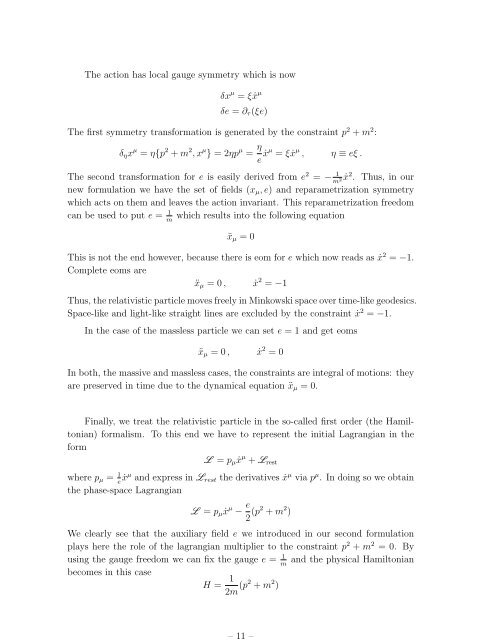Lectures on String Theory
Lectures on String Theory
Lectures on String Theory
You also want an ePaper? Increase the reach of your titles
YUMPU automatically turns print PDFs into web optimized ePapers that Google loves.
– 11 –<br />
The acti<strong>on</strong> has local gauge symmetry which is now<br />
δx µ = ξẋ µ<br />
δe = ∂ τ (ξe)<br />
The first symmetry transformati<strong>on</strong> is generated by the c<strong>on</strong>straint p 2 + m 2 :<br />
δ η x µ = η{p 2 + m 2 , x µ } = 2ηp µ = η e ẋµ = ξẋ µ , η ≡ eξ .<br />
The sec<strong>on</strong>d transformati<strong>on</strong> for e is easily derived from e 2 = − 1 ẋ 2 . Thus, in our<br />
m 2<br />
new formulati<strong>on</strong> we have the set of fields (x µ , e) and reparametrizati<strong>on</strong> symmetry<br />
which acts <strong>on</strong> them and leaves the acti<strong>on</strong> invariant. This reparametrizati<strong>on</strong> freedom<br />
can be used to put e = 1 which results into the following equati<strong>on</strong><br />
m<br />
ẍ µ = 0<br />
This is not the end however, because there is eom for e which now reads as ẋ 2 = −1.<br />
Complete eoms are<br />
ẍ µ = 0 , ẋ 2 = −1<br />
Thus, the relativistic particle moves freely in Minkowski space over time-like geodesics.<br />
Space-like and light-like straight lines are excluded by the c<strong>on</strong>straint ẋ 2 = −1.<br />
In the case of the massless particle we can set e = 1 and get eoms<br />
ẍ µ = 0 , ẋ 2 = 0<br />
In both, the massive and massless cases, the c<strong>on</strong>straints are integral of moti<strong>on</strong>s: they<br />
are preserved in time due to the dynamical equati<strong>on</strong> ẍ µ = 0.<br />
Finally, we treat the relativistic particle in the so-called first order (the Hamilt<strong>on</strong>ian)<br />
formalism. To this end we have to represent the initial Lagrangian in the<br />
form<br />
L = p µ ẋ µ + L rest<br />
where p µ = 1 eẋµ and express in L rest the derivatives ẋ µ via p µ . In doing so we obtain<br />
the phase-space Lagrangian<br />
L = p µ ẋ µ − e 2 (p2 + m 2 )<br />
We clearly see that the auxiliary field e we introduced in our sec<strong>on</strong>d formulati<strong>on</strong><br />
plays here the role of the lagrangian multiplier to the c<strong>on</strong>straint p 2 + m 2 = 0. By<br />
using the gauge freedom we can fix the gauge e = 1 and the physical Hamilt<strong>on</strong>ian<br />
m<br />
becomes in this case<br />
H = 1<br />
2m (p2 + m 2 )

















